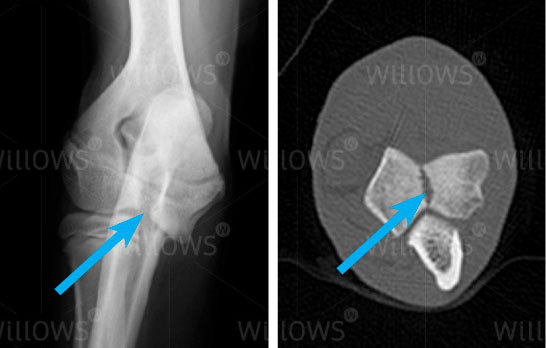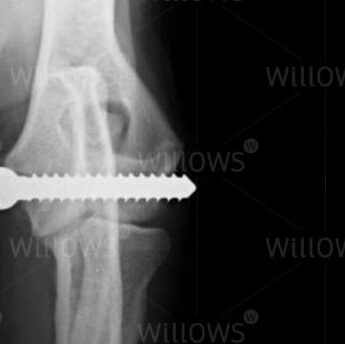Why Should I Bring my Pet to Willows for Treatment of a Humeral Intracondylar Fissure (HIF)?
Willows is one of Europe’s leading small animal Orthopaedic referral centres treating over 1000 new patients a year. Our state-of-the-art hospital is led by internationally renowned Specialists committed to providing the highest standards of care. Our team of Orthopaedic Specialists have considerable collective experience of treating pets with HIF.
Our Orthopaedic Surgeons are supported by our multi-disciplinary team of Specialists across a number of disciplines including; Anaesthesia, Diagnostic Imaging and Emergency and Critical Care. Willows has a large dedicated team of Nurses and clinical support staff available 24 hours a day, every day of the year to provide the best possible care for your pet.
What is a Humeral Intracondylar Fissure?
The humeral condyle is the name given to the end of the bone at the top of the front leg. The humeral condyle, together with the two bones of the forearm (radius and ulna) makes up the elbow joint. When the humeral condyle breaks, the elbow joint is fractured and will not work properly. Fractures of the elbow joint are amongst the most common type of broken bone seen in dogs; they rarely occur in cats. In some dogs, a crack or opening (fissure) can form across the humeral condyle, this is known a humeral intracondylar fissure (HIF). Humeral intracondylar fissure has also been referred to as incomplete ossification of the humeral condyle (IOHC).
What are the Common Causes for a Humeral Intracondylar Fissure?
The exact reason for the development of HIF remains unclear. In some young puppies HIF is likely a developmental problem, although the majority of dogs appear to develop HIF when they are adults. Spaniel breeds, in particular Springer Spaniels are most commonly affected, although in recent years HIF has been identified in other breeds such as the French bulldog.

What are the Signs of a Humeral Intracondylar Fissure?
Some dogs will develop a persistent and progressive limp in their affected front leg due to pain related to the HIF. Humeral intracondylar fissure can also predispose the elbow joint to developing a complete fracture or break. In such situations these fractures are often not caused by any major trauma, but can occur during normal exercise.
Fig 1: X-ray showing a humeral condylar fissure (arrow)
Fig 2: CT scan showing a humeral condylar fissure (arrow)

How are Humeral Intracondylar Fissures Diagnosed?
Examination of your pet will generally identify elbow pain and often show reduced muscle in the affected leg. Large fissures or cracks within the humeral condyle can be detected on X-rays, however incomplete or subtle fissures can often only be diagnosed on a CT scan. Because humeral condylar fissures often affect both front legs, a CT scan both elbows is usually recommended.

How can Humeral Intracondylar Fissures be Treated?
When HIF is causing lameness surgery is recommended to reduce elbow pain, to hopefully resolve the dogs limp and to reduce the risk of the humeral condyle fracturing. The operation involves accurately placing a large screw across the humeral condyle through a small skin incision. In the past this operation carried a high risk of complications, including the build up of fluid under the skin (seroma) and infection. In recent years, new techniques have been developed for carrying out the operation which has led to a much reduced complication rate. In some patients HIF may be detected on an X-ray or a CT scan before it causes a problem for the dog. In such situations surgery to place a screw may be performed prophylactically.
Fig 3: X-ray following surgery showing the placement of a screw to treat a humeral condylar fissure

What can I expect if my pet is treated for a humeral intracondylar fissure?
Most dogs are very comfortable following surgery and are able to go home the next day with only a light dressing. They can start walk and place weight on the limb within a day or two, off the lead exercise such as running or jumping must be avoided for approximately three weeks. Painkillers are given for a few weeks to ensure the pet is comfortable. Pets that have undergone surgery will need to be taken to their local Vet for a check-up at one week and then after two weeks to have stiches removed. Willows will then plan to see your pet for reassessment after six weeks when follow up X-rays may be taken.
With new surgical techniques the complication rate following surgery is now much lower than in the past. The majority of dogs will be recover well within a few weeks of the operation and can regain a normal quality of life. In the long term, we do not expect the HIF to heal. As a result dogs have to rely on the implanted screw to support their weight for the rest of their lives. With every step such dogs take, a small force is placed on the screw, and in some, over time, this can lead to the screw breaking. If this occurs, another operation may be required to replace the screw.
To save this page as a PDF, click the button and make sure “Save as PDF” is selected.
Orthopaedics
Find out more
To assist owners in understanding more about Orthopaedics we have put together a range of information sheets to talk you through the some of the more common orthopaedic conditions seen and treated by our Specialists.

